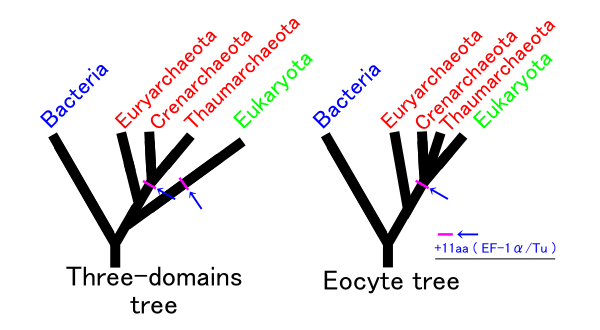Tacks on:
[Wikipedia]
[Google]
[Amazon]
Thermoproteati is a kingdom of

archaea
Archaea ( ) is a Domain (biology), domain of organisms. Traditionally, Archaea only included its Prokaryote, prokaryotic members, but this has since been found to be paraphyletic, as eukaryotes are known to have evolved from archaea. Even thou ...
. Its synonym
A synonym is a word, morpheme, or phrase that means precisely or nearly the same as another word, morpheme, or phrase in a given language. For example, in the English language, the words ''begin'', ''start'', ''commence'', and ''initiate'' are a ...
, "TACK", is an acronym for Thaumarchaeota (now Nitrososphaerota
The Nitrososphaerota (syn. Thaumarchaeota) are a phylum of the Archaea proposed in 2008 after the genome of '' Cenarchaeum symbiosum'' was sequenced and found to differ significantly from other members of the hyperthermophilic phylum Thermopr ...
), Aigarchaeota, Crenarchaeota (now Thermoproteota
The Thermoproteota are prokaryotes that have been classified as a phylum (biology), phylum of the domain Archaea. Initially, the Thermoproteota were thought to be sulfur-dependent extremophiles but recent studies have identified characteristic T ...
), and Korarchaeota (now Thermoproteota), the first groups discovered. They are found in different environments ranging from acidophilic thermophiles to mesophiles and psychrophiles
Psychrophiles or cryophiles (adj. ''psychrophilic'' or ''cryophilic'') are extremophilic organisms that are capable of growth and reproduction in low temperatures, ranging from to . They are found in places that are permanently cold, such as th ...
and with different types of metabolism
Metabolism (, from ''metabolē'', "change") is the set of life-sustaining chemical reactions in organisms. The three main functions of metabolism are: the conversion of the energy in food to energy available to run cellular processes; the co ...
, predominantly anaerobic and chemosynthetic. Thermoproteati is a kingdom that is sister to the Asgard
In Nordic mythology, Asgard (Old Norse: ''Ásgarðr''; "Garden of the Æsir") is a location associated with the gods. It appears in several Old Norse sagas and mythological texts, including the Eddas, however it has also been suggested to be refe ...
branch that gave rise to the eukaryotes
The eukaryotes ( ) constitute the domain of Eukaryota or Eukarya, organisms whose cells have a membrane-bound nucleus. All animals, plants, fungi, seaweeds, and many unicellular organisms are eukaryotes. They constitute a major group of ...
. It has been proposed that the Thermoproteati kingdom be classified as "Crenarchaeota" and that the traditional "Crenarchaeota" (Thermoproteota) be classified as a class called "Sulfolobia", along with the other phyla
Phyla, the plural of ''phylum'', may refer to:
* Phylum, a biological taxon between Kingdom and Class
* by analogy, in linguistics, a large division of possibly related languages, or a major language family which is not subordinate to another
Phy ...
with class rank or order. After including the kingdom category into ICNP, the only validly published name of this group is kingdom Thermoproteati (Guy and Ettema 2024).
Classification
*Thermoproteota
The Thermoproteota are prokaryotes that have been classified as a phylum (biology), phylum of the domain Archaea. Initially, the Thermoproteota were thought to be sulfur-dependent extremophiles but recent studies have identified characteristic T ...
(formerly "Crenarchaeota"). It is the best-known edge and the most abundant archaea
Archaea ( ) is a Domain (biology), domain of organisms. Traditionally, Archaea only included its Prokaryote, prokaryotic members, but this has since been found to be paraphyletic, as eukaryotes are known to have evolved from archaea. Even thou ...
in the marine ecosystem. They were previously called sulfobacteria because of their dependence on sulfur and are important as carbon fixers. There are hyperthermophiles in hydrothermal vents and other groups are the most abundant at depths of less than 100 m.
* " ''Candidatus'' Augarchaeota". It is a phylum proposed from the genome of the candidate
A candidate, or nominee, is a prospective recipient of an award or honor, or a person seeking or being considered for some kind of position. For example, one can be a candidate for membership in a group (sociology), group or election to an offic ...
species "''Candidiatus'' ''Caldiarchaeum'' ''subterraneum''" (now belongs to Thermoproteota as "''Candidiatus Caldarchaeum subterraneum''") found deep within a gold mine in Japan
Japan is an island country in East Asia. Located in the Pacific Ocean off the northeast coast of the Asia, Asian mainland, it is bordered on the west by the Sea of Japan and extends from the Sea of Okhotsk in the north to the East China Sea ...
. Genomic sequences of this group have also been found in geothermal environments, both terrestrial and marine.
Phylogeny
The relationships are roughly as follows:
Eocyte hypothesis
The eocyte hypothesis proposed in the 1980s by James Lake suggests thateukaryotes
The eukaryotes ( ) constitute the domain of Eukaryota or Eukarya, organisms whose cells have a membrane-bound nucleus. All animals, plants, fungi, seaweeds, and many unicellular organisms are eukaryotes. They constitute a major group of ...
emerged within the prokaryotic
A prokaryote (; less commonly spelled procaryote) is a single-celled organism whose cell lacks a nucleus and other membrane-bound organelles. The word ''prokaryote'' comes from the Ancient Greek (), meaning 'before', and (), meaning 'nut' ...
eocytes.
One piece of evidence supporting a close relationship between Thermoproteati and eukaryotes is the presence of a homolog of the RNA polymerase subunit Rbp-8 in Thermoproteota but not in Euryarchaea.
See also
*List of Archaea genera
This article lists the genera of the Archaea. The currently accepted taxonomy is based on the List of Prokaryotic names with Standing in Nomenclature (LPSN) and National Center for Biotechnology Information (NCBI). However, in the List provided bel ...
References
{{Taxonbar, from=Q47002232 Archaea taxa Kingdoms (biology)